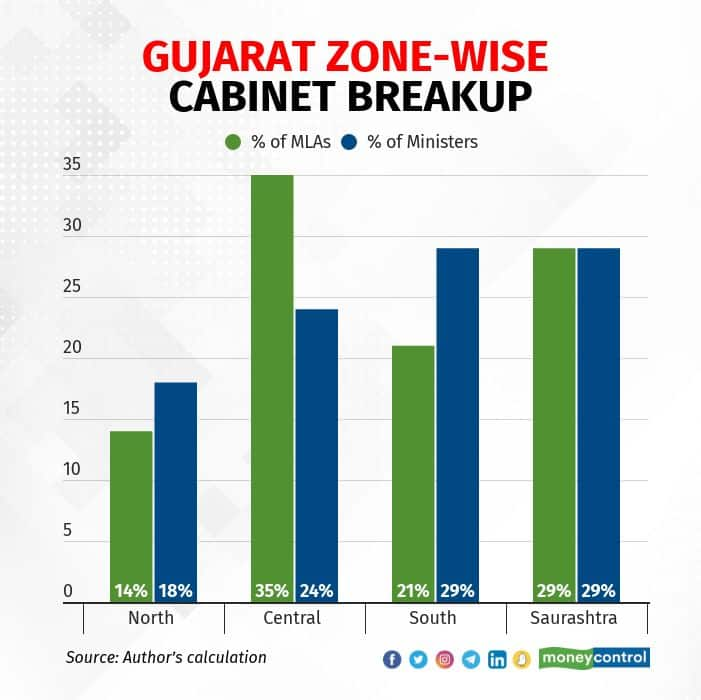



The Cabinet formation in Gujarat highlights the Bharatiya Janata Party (BJP)’s new social engineering in the state, and carries a subtle message for the general elections in 2024. Around 60 percent of the Cabinet comprises members from the Other Backward Class (OBC), the Scheduled Caste (SC), and Schedule Tribe (ST) community, which is emerging as the core vote block of the national party.
The party has also kept its traditional supporters, the upper caste, in good humour, giving them representation in proportion of their population: three ministries, in Balvantsinh Rajput, Kanu Desai, and Harsh Sanghvi.
The Patidars continue with their dominance in Gujarat politics, occupying one-fourth of the Cabinet positions, including the coveted Chief Minister’s chair with Bhupendra Patel. The other three are, Rushikesh Patel, Raghavjibhai Patel, and Prafulla Pansheriya.
A section of Patidars had backed the Congress in 2017 seeking reservation for the community. With the exit of Hardik Patel, and the implementation of a 10 percent quota for the economic weaker sections, many Patidars have come back to supporting the BJP.

As per Axis exit polls, the BJP received 8 percent more support from Kadwa, and 16 percent from Leva Patels vis-a-vis the 2017 assembly elections.
The BJP has rewarded the tribal community after having routed Congress in the ST reserved seats for the first time in the last three state elections, by giving ministerial berths to Kunwar Halpati, and Kuber Dindor.
The BJP’s unsaid policy of not giving representation to the minorities gives it a leeway to utilise their quota (10 percent of population in Gujarat) for communities it wishes to woo for future polls/accommodation/reward. IN that vein, it has given only one seat to the Maldhari community, which had called for a boycott of the BJP in the run-up to the polls.
Rewarding And Consolidating
The BJP has also broken the Congress’ citadel of the north zone, which stood by the grand old party in 2012 and 2017. For this, the BJP gave higher number of tickets to Thakors, matching Congress’ numbers, to woo the community. In the Cabinet, the BJP has given a higher representation to MLAs from the north zone, in Balvantsinh Rajput, Rushikesh Patel, and Bhikusinh Parmar.
The BJP has swept Surat once again despite significant push by the Aam Aadmi Party (AAP) and its star candidates contesting from the district. The diamond hub stood firmly behind the BJP. Surat district alone has four ministers in the Cabinet — Mukesh Patel, Kunwar Halpati, Praful Pansheriya, and Harsh Sanghvi.
While the party is known to have the backing of big business houses, small businessmen and traders have not ditched the party, as was expected by AAP.
The influential Koli community, which comprises 18 percent population in the Kutch-Saurashtra region and which has considerable influence in the south zone, has been allotted three ministerial berths. About 7 percent more Kolis voted for the BJP this election, which tilted the scale in favour of party in agrarian/rural Saurashtra; the region had backed the Congress in 2017. Koli strongman Parshotam Solanki, Mukesh Patel, and Kunwarjibhai Bavaliya have earned ministerial berths.
Four Congress turncoats — Kunvarji Bavaliya, Raghavji Patel, Balwantsinh Rajput, and Kunvarji Halpati — have been made ministers, sending a signal to the opposition MLAs of the rewards of switching camps. This is a message not just for the Congress, but for AAP which has electoral ambitions in the state. Gujarat has a history of exodus of MLAs from the Congress to the BJP, and an AAP MLA is rumoured to be in talks to jump ship.
The Cabinet is heavily tilted towards MLAs elected from rural Gujarat—this is a clear attempt by the BJP to shed its image being an urban/semi-urban party. Almost three-fourth of the ministers represent rural seats.
Adequate Representation
The Cabinet of any state government, or of that at the Centre, should give adequate representation of all sections of society. The MLAs from all regions of the state should find a place in the ministry for holistic development.

To determine the composition of its ministry, a party can use any of the following methods: One, ministers can be selected in proportion to the population of each caste/community in the state. Two, minister can be decided depending on the proportion of MLAs elected on the party’s ticket. Three, ministers can be selected depending on the proportion of votes the party has received from various communities. Another method would be to select ministers to reflect the cross-section of the state, so as every community is represented in the Cabinet. The BJP has employed a mix of the first three methods to balance and satisfy all sections. The party has left 10 positions vacant, and one can expect it to be used in future.
Amitabh Tiwari is a former corporate and investment banker-turned political strategist and commentator. Twitter: @politicalbaaba. Views are personal and do not represent the stand of this publication.
Discover the latest Business News, Sensex, and Nifty updates. Obtain Personal Finance insights, tax queries, and expert opinions on Moneycontrol or download the Moneycontrol App to stay updated!
Find the best of Al News in one place, specially curated for you every weekend.
Stay on top of the latest tech trends and biggest startup news.